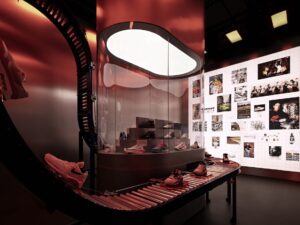With the exhibition on Zanele Muholi, Gropius Bau has proven once more that it is one of the most progressive exhibition venues Berlin has to offer. Curator Natasha Ginwala in conversation with Fräulein.
IN CONVERSATION: GROPIUS BAU‘ CURATOR NATASHA GINWALA
Curated by series, some unfinished and continuing, the exhibition at Gropius Bau highlighted the work of South African artist Zanele Muholi. Muholi tells the stories of Black lesbian, gay, bisexual, queer, trans* and inter* people in South Africa. Over 200 photographs were exhibited, sometimes sensual, sometimes intense, but always activist, depicting realities of life and honoring individuals. If tender images of same-sex couples are depicted in the Being series, their earliest works Only Half the Picture show queer experiences. Their most recent series Somnyama Ngonyama are self-portraits that negotiate issues of self-representation and race. Another highlight of the exhibition is the visual archive, Faces and Phases, which uses portraits to paint a vivid collective picture of this community of which Muholi themself is a part.

Fräulein: Hi Natasha! Maybe we could start with you telling me a bit about the exhibition and the background. How how did it come about? What were the thoughts, how was the progress like?
Natasha Ginwala: Thank you for opening this conversation. The Zanele Muholi survey exhibition at Gropius Bau is the largest of its kind as of date. It started at the Tate Modern in London, the curators were Yasufumi Nakamori and Sarah Allen. And it has since traveled to different cultural venues, and for us at Gropius Bau, it’s been an incredible experience to host this exhibition and to co-organize it. I joined the curators of the Tate to work specifically on the Gropius Bau iteration of the exhibition, which is at the second floor of the building. Given the history of photographic practices exhibited at Gropius Bau and particularly what such an exhibition means for Berlin audiences, we’re very conscious of its inherent power in widening ideas of participation and storytelling as this photographic practice deeply wrestles with historical and contemporary aspects of sexuality, of racial violence, but also of joy, activism, and kinship that is built on the basis of love, bold desires and the quest of (re)claiming sexual freedom. These are subjects which have been considered in impactful ways through other artists such as Wu Tsang, Theaster Gates, Akinbode Akinbiyi, and Vaginal Davis among others in our programme thus far. Braiding questions of beauty, queer consciousness, and the power of representation, therein creating a visual archive that centers the lives of LGBTQIA+ participants have been significant for Zanele Muholi.
Fräulein: That’s super interesting. So when we are talking about the spatial organization of the exhibition, why do you think was it important to structure the exhibition according to their series of work?
Natasha: When there is such a huge body of work and a series of works which have been made over 20 years, the question for me personally was: How do you introduce this practice? And we studied carefully the way that Tate Modern had used their spaces to hold this exhibition. In our case, it was quite different because we actually moved from an early series Being, which is developed in the early 2000s but is also ongoing, because we felt that this is a space of intimacy and care, from daily rituals to different forms of partnership and friendship between Muholi and their participants, between LGBTQIA+ communities and activists. What does it mean to reveal pleasure and vulnerability at the same time? There are just six photographs in that first room. One photograph portrays a couple holding onto one another in bed, it is hung quite low and is the only image on that wall, to respectfully encounter Black lesbian intimacy is the point. And I felt that’s a very powerful way to invite audiences, to give them time to also let the images enter one’s consciousness, to see how accepting one is, to see what causes us to build prejudices or reject certain kinds of images of sexuality – in that respect of acceptance and embracing different forms of gender diverse companionship, chosen family, and passion. We really went by following Muholi’s trajectory, approach and thought about how we can further build awareness and complex dialogues with the public. The exhibition goes from Being to Only Half The Picture, which is the earliest series of work, and that is also where you see how Muholi initiated the place of photography as the core of their visual activism. That’s also where we exhibited the early newsletters of Forum for the Empowerment of Women (FEW), documents from the Market Photo Workshop and a feedback form received at their earliest exhibition. These are notable elements that are not always included within a monographic show. Of course, a lot of credit goes to the Tate curators for generating those resources together with Muholi and their studio.


Fräulein: Would you say that the way of displaying their work is deeply connected to Muholi’s photographic practice? In terms of representation, but also trying to let the subject speak for themselves.
Natasha: Muholi has addressed on different occasions what it means to set up circumstances for those in their photographs to collaborate in the act of image making as participants. So the question is not about letting ‘the subject speak’ but rather come into the fullness of their being, to be fearless before the camera, having confidence and pleasure in that experience. In the first series, Only Half the Picture there are images of violence and extreme brutality that lay down the history and present of hate crimes in South Africa. Here too there is respect in the act of building a visual encounter as image-making is a part of co-witnessing and eventually also of recovery through community support. The title Somnyama Ngonyama is drawn from isiZulu, Muholi’s mother tongue, and is a way of creating a sense of lifting up one’s inheritance, one’s lineage, particularly coming from the side of a maternal figure who in this case is Bester Muholi. Muholi has shared that there are very few images that they have of their mother. This series therefore is deeply personal in the way it chronicles the realm of matriarchal ancestors, domestic labour, apartheid history and contemporary events in South Africa through portraiture. They don’t like the word performative, so they don’t see the work, the photographs in that sense, but rather the visual frame operates in my view as an enlivening gesture and reclaiming of spaces, sightlines, and oppressed memory. For too long, labouring protagonists have been documented by the colonial gaze. In the case of domestic labor especially, gender-based stereotypes and exploitation goes along with it in many parts of the world, I think that’s something to reflect on in relation to this series because there is a move toward self-empowerment and of repossessing these tools and implements of labor, whether that’s a laundry clip, doormat or other kinds of symbols that are artifacts of that labor, which are then worn with pride and dignity often as crowns and glorious garments.
Fräulein: I would like to talk to you a bit about the Being series, because when I visited the exhibition, these images had a pretty strong impact on me, but also the people surrounding me. How like the sensuality of these images can generate subversion or even challenge prevailing stereotypes?
Natasha: I’m glad that those images had such an impact on you. Given that, I couldn’t meet Muholi while working on the show. And for me personally, I work very closely with artists, sometimes over several years, and so in this instance of curating through pandemic holding a process-led dialogue was something I missed. There was something that drew me into these images and led to thinking about the way Bell Hooks writes on love and healing: “Rarely if ever, are any of us healed in isolation. Healing is an act of communion.” It also brings forth reflections on the lives of queer protagonists, historically. I’ve been personally very drawn to the life and work of Audre Lorde. There are so many other figures, also not only in the African-American context, but also in the South Asian context. And I felt that there could be an affective encounter; particularly given that this survey exhibition is happening during a health emergency. We’re very conscious of our bodies and about the presence of our bodies in space, about the distance between bodies. I felt that we should start with this series where there is a baring of the soul and of intimacy, which is beyond the binary and heteronormative desire. The everydayness of love and care giving is poignant here, particularly that image of women who are bathing together, that is part of this series. I learnt a lot about Muholi’s practice by looking over and again at the same picture. After exiting the room with the display of Faces and Phases audiences directly move into a historical and biographical timeline that intertwines Muholi’s life and professional events with legacies of gender injustice, resistance movements and advocacy in South Africa.

Fräulein: Faces and Phases is obviously a major body of work. You already said it’s an ongoing series. What kind of the role can an archive play, what can an archive do and why is it particularly important in Muholi’s practice?
Natasha: Faces and Phases is located at the conclusion of this exhibition – as Muholi chronicles through it a visual history of their community – this ‘archive’ boldly faces the future against great odds. Of course, this is a survey exhibition of Zanele Muholi, but what does that mean for each and every participant who is integral to their practice? I can’t see one without the other, the communal register is seminal. And it has that plural consciousness about it, so when you look around the room ‘Collectivity’, where visitors meet with various occasions in the lifeline of the LGBTQIA+ community in South Africa especially, you realize that certain moments, whether that is birth, marriage, death, many other kinds of moments of celebration and of loss are often not accompanied by those of a biological family but rather by the community who choose one another. They are documented and attended by Muholi and by members of their collective INKANYISO. These forms of documentation or the production of ‘queer media’ as they put it, bring forth liberating and freeing modes of choosing to stay present, visible, and decisive. Faces and Phases has been exhibited in different parts of the world, what is significant within this series is that it marks far more than moment of making the picture, it echoes friendships, transformations, sociality, and thus revisiting the same participant over a number of years. It also remembers those who have passed on.
Fräulein: The concept of intersectionality describes how various forms of discrimination centred on race, gender, class, disability, sexuality, and other forms of identity, do not work independently but interact to produce particularized forms of social oppression. How do these categories interact in their work?
Natasha: I feel like there are often artificial and even flawed divisions made between these subjects and intersectionality is not a new concept when one observes long-running civic struggles and anti-colonial movements. The way that Muholi addresses Black trans and lesbian lives is what is empowering and defiant, the question of beauty is explored in a way that is not separate from the question of race or the question of power or facets of sexuality and transformation. It is all enmeshed. It’s inseparable. And it is the hierarchies and hegemonies of the world and its systemic violence that cause forced divisions and narrow categories. And that’s particularly why image making has that sheer capacity to create a unity between interdependent subjects, in a way that you cannot refuse. The visual encounter is one that is connected to the person in the image, and equally connected to the being looking at the image.
Fräulein: That was quite a beautiful answer. Thank you. So what kind of upcoming exhibitions are planned at Gropius Bau? What can we expect?
Natasha: An upcoming exhibition at Gropius Bau presents Dayanita Singh’s oeuvre, curated by Stephanie Rosenthal. Personally, I’m quite excited about the exhibition, because Dayanita (Singh) is someone whose work I’ve been following closely. Her relationship with image-making is fundamentally spatial and articulated through the book object, in conversation with friends who include musicians, writers, architects and people she has been connected to over several years. She builds new structural relationships with photographs thinking through circulation, reading, and economies of inhabitation. There’s a lot to learn and acknowledge from the methods that she has carefully crafted as a woman photographer, who has tackled these subjects head on. This september, there’s a group exhibition, which connects to a 4 day program that was held last year in November, around the topics of care, healing and repair. And this exhibition is something that really brings together a lot of the subjects that we remain concerned with through an ongoing systemic collapse. And it does so with artists and curators, Brook Andrew, Kader Attia, Stephanie Rosenthal, Serafine1369, myself and as well as researchers who are part of this endeavor. It is an exercise around how to make an exhibition in ways that are sensitive to these very large topics that also affect us every single day.

A virtual tour through the exhibition can be watched here.
Interview by Antonia Schmidt
All images: Zanele Muholi, Installation view, 2021, Gropius Bau, Berlin. © Photo: Eike Walkenhorst



